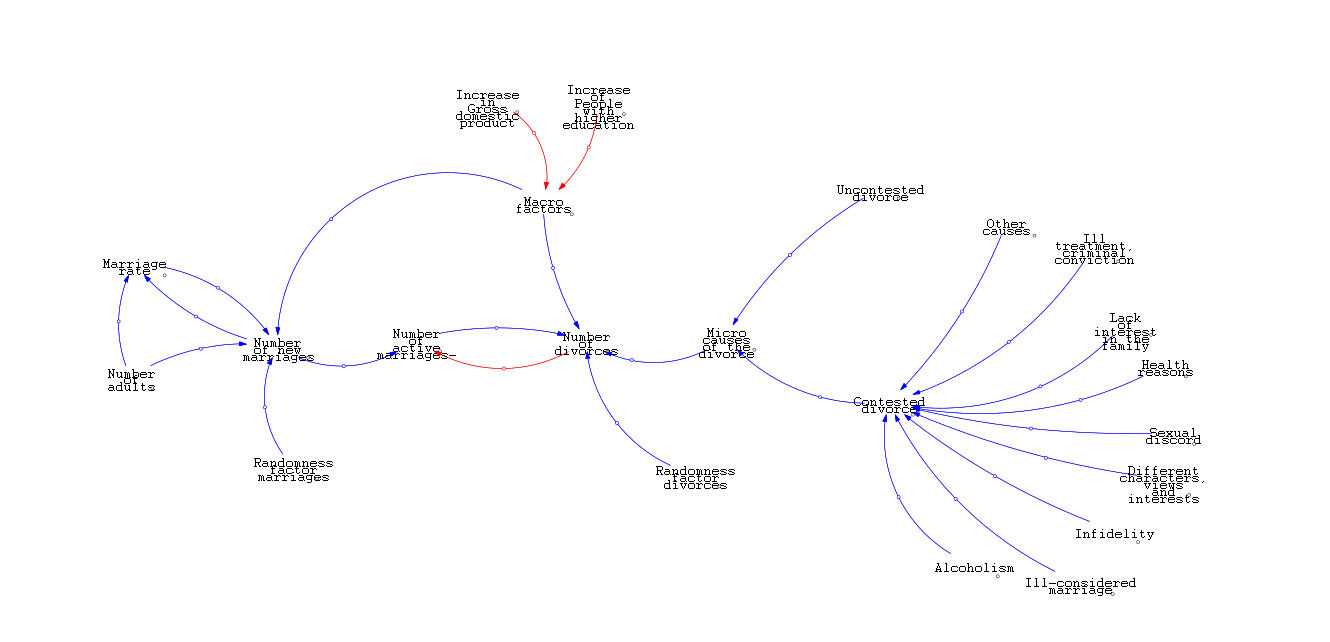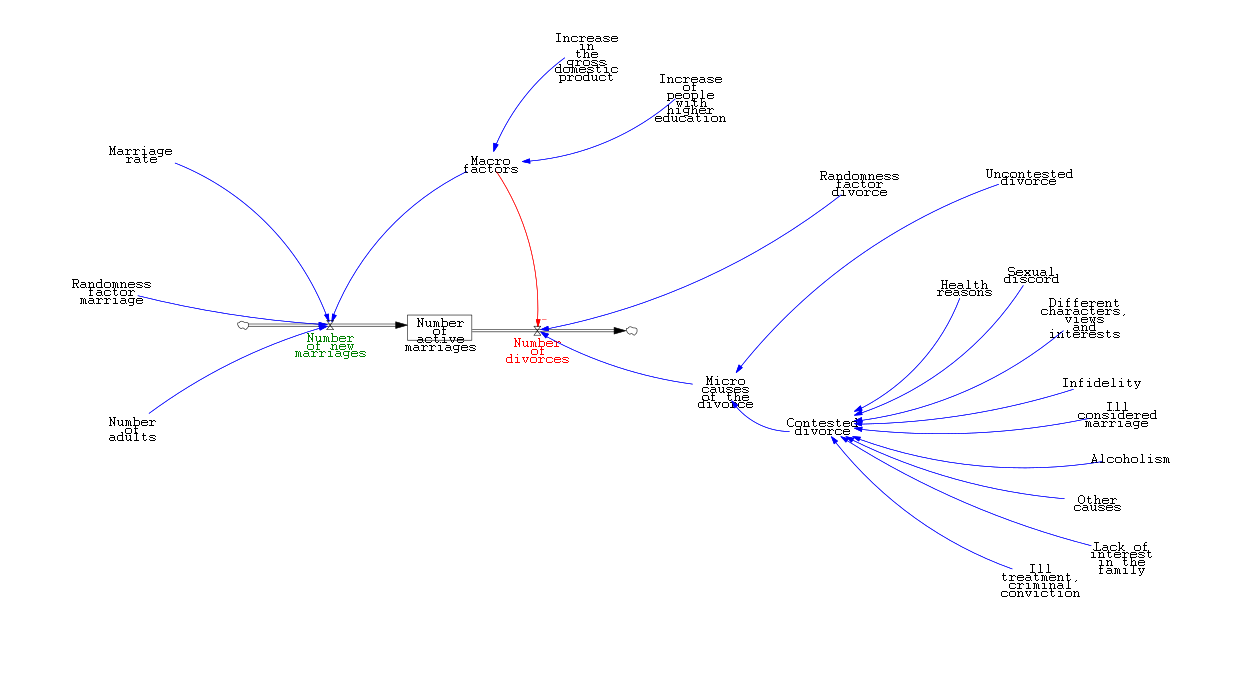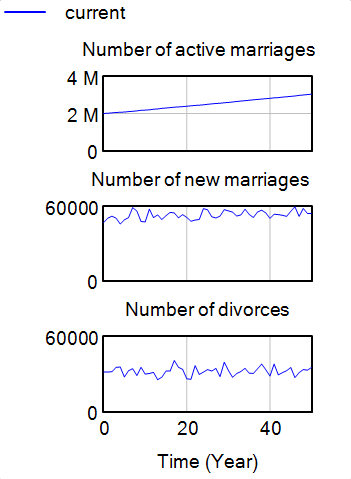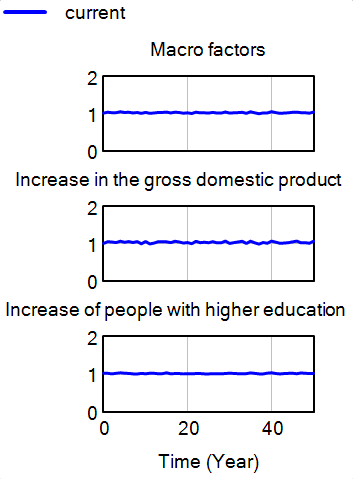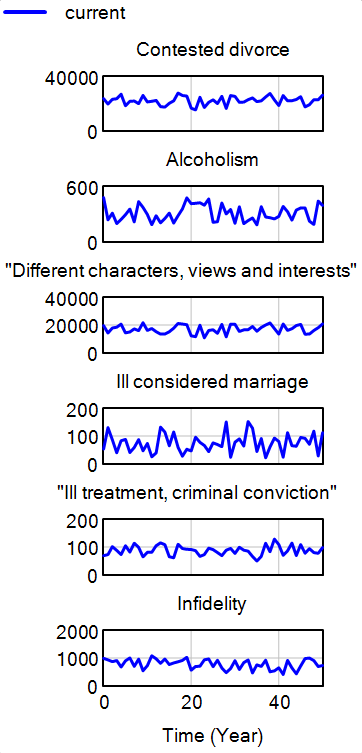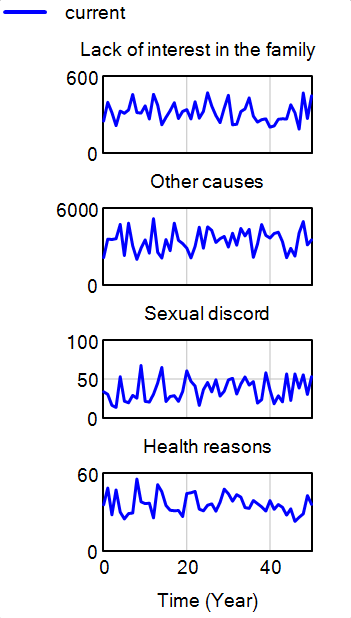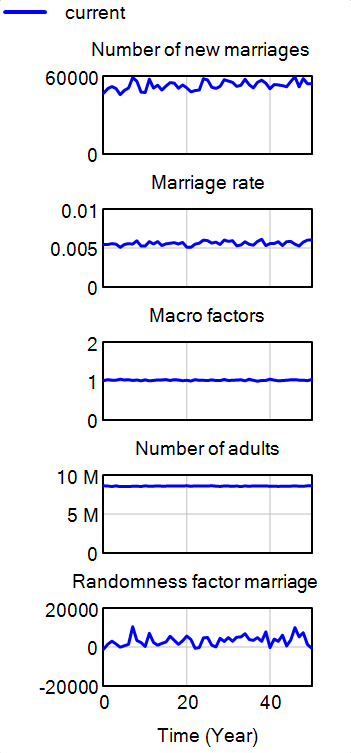Difference between revisions of "Divorce prediction for 50 years"
(→Results) |
(→Code) |
||
| (6 intermediate revisions by the same user not shown) | |||
| Line 59: | Line 59: | ||
After all the theories were verified, the Causal Loop Diagram using only the parameters that were confirmed in the previous part, all using the identified theories and data from the Czech Statistical Office. | After all the theories were verified, the Causal Loop Diagram using only the parameters that were confirmed in the previous part, all using the identified theories and data from the Czech Statistical Office. | ||
| − | [[File: | + | [[File:Luxa00loop.PNG]] |
| − | |||
| − | |||
==Parameters calculation== | ==Parameters calculation== | ||
| Line 92: | Line 90: | ||
<code> Number of active marriages = Number of new marriages - Number of divorces </code> | <code> Number of active marriages = Number of new marriages - Number of divorces </code> | ||
| + | |||
| + | Based on all these parameters and the calculation, the Stock and flow model was created. The initial time set was 0, The final time 50 and the units of time were set to Years. | ||
| + | |||
| + | [[File:Luxa00model.PNG]] | ||
=Results= | =Results= | ||
| Line 100: | Line 102: | ||
[[File:luxa002.png]] | [[File:luxa002.png]] | ||
| − | [[File: | + | [[File:Contested divorce.png]] |
[[File:luxa004.png]] | [[File:luxa004.png]] | ||
| Line 111: | Line 113: | ||
=Code= | =Code= | ||
| − | + | [[Media:Divorce.zip]] | |
| − | |||
=Sources= | =Sources= | ||
Latest revision as of 10:59, 27 January 2023
Contents
Problem definition
Divorce is unfortunately very common in the current time. The reasons are various, all of them are however stated in the divorce papers. To be able to get divorced, the ex-couple must always attend at least one hearing in front of the court. Legally, there are many more parties involved, such as a notary, who must verify the signatures on all the important documents and many times, divorce lawyers are also necessary. To be able to satisfy the needs of the public, all the involved parties must have an idea about how many married couples are likely to get divorced in the years to come. This simulation will help prepare the courts, notaries and lawyers by making a prediction on the number of divorces in the next 50 years. This will also help law students choose the field of law that they will specialize in by answering the question whether divorce lawyers will be necessary in the future or not.
Method
Because there were multiple independent risk factors and reasons that cause divorce identified, Vensim was evaluated as the best tool for the performance of the simulation. The simulation uses data from the Czech Statistical Office and also studies on the reasons for divorce; all the data is from year 2009 to 2021 as older data could not be found and 12 years’ worth of data has been evaluated to be sufficient. Note: Please note that the data for 2022 will be published in October 2023, therefore data up to the year 2021 is be used for this simulation.
Micro causes of the divorce
The document Statistická ročenka České republiky, which is published every year in October by the Czech Statistical Office, contains chapter C.10 Rozvody podle příčiny rozvratu manželství (Divorces: by cause of marriage breakdown) with the reasons for divorce, as stated by the divorcees in the divorce papers. The reasons are as follows: a/ Ill-considered marriage b/ Alcoholism c/ Infidelity d/ Lack of interest in the family (incl. abandon. of living together) e/ Ill-treatment, criminal conviction f/ Different characters, views and interests g/ Health reasons h/ Sexual discord i/ Other causes j/ Cause not given
After an examination of the data, two unclear reason categories were identified – “Other causes” and “Cause not given”. Based on further research, it was discovered that in case in the year 2014, a new amendment to the Divorce Act has been introduced and put into effect. Based on this, the divorces were categorized as (a) uncontested or (b) contested. The first of the categories describes the situation, where both partners agree on all requirements of the divorce, for example the division of properties and caring for the offspring, in such case, the court does not try to discover the reason for the separation, therefore these cases are the ones in the “Cause not given” category. On the other hand, during the resolution of the contested divorce, the court does search for the reason of the breakup of the marriage. The enforcement of the amendment in 2014 is clearly visible in the data, where the “Cause not given” reason rises extremely since the affected year. (Jirsa, 2014) The second reason category “Other causes” describes the cases, which cannot be classified as any of the other reasons available and is used during the solution of the contested divorce.
Additionally, it is important to point out that the reasons for the divorce are stated by both parties (wife, husband), meaning that there were twice as much reasons as there were divorces. To be able to process this discrepancy, the sums of reasons as stated by the women were added to the relevant sums of reasons stated by the men and this value was divided by 2 to ensure that there was a same amount on data on causes as there were divorces. Because of this method, it is possible to see values with decimal point in the data set – this is not a mistake though. Example (we abstract from other reasons): 22 women said that the reason for the ending of their marriage was infidelity. On the other hand, 18 men also stated the same reason for their divorce, the data from the Czech Statistical Office would show 20 divorces for this case, however if we add up the reasons, we would get a total of 40 divorces as both parties are obligated to state their reason. For the sake of this simulation, the total number of the listed causes would be added up and divided by two, resulting in the number of 20 infidelity caused divorces.
Additionally, it is important to point out that the reasons for the divorce are stated by both parties (wife, husband), meaning that there were twice as much reasons as there were divorces. To be able to process this discrepancy, the sums of reasons as stated by the women were added to the relevant sums of reasons stated by the men and this value was divided by 2 to ensure that there was a same amount on data on causes as there were divorces. Because of this method, it is possible to see values with decimal point in the data set – this is not a mistake though.
Example (we abstract from other reasons): 22 women said that the reason for the ending of their marriage was infidelity. On the other hand, 18 men also stated the same reason for their divorce, the data from the Czech Statistical Office would show 20 divorces for this case, however if we add up the reasons, we would get a total of 40 divorces as both parties are obligated to state their reason. For the sake of this simulation, the total number of the listed causes would be added up and divided by two, resulting in the number of 20 infidelity caused divorces.
Macro factors
For the prediction of the future divorce, the factors identified in the studies by Scott, S. B. et al. (2013) and Hawkins et al. (2012), Fučík (2013) and IDFA (not dated) were used. The factors are:
- Religion (Hawkins et al., 2012) – the more religious people there are, the less divorces.
- Level of education (Fučík, 2013) – the higher level of education (high school and above) means less divorces – parameter is named People with higher education.
- Women’s financial independence (Society, 2018) – the more financially independent women are, the more divorce there will be.
- Money issues (IDFA, not dated) – the more money issues there are, the more divorce. Parameter is named Country economic performance.
Firstly, the amount of religious Czech citizens was analysed using the data from the relevant Census of the Czech Republic, i.e., data from 2011 and 2021 census. It was found that the amount of Czech religious people is lowering. This information is not in line with the result of the study and therefore this parameter cannot be used. Next, using the same data, let us talk about the Education level parameter. The theory states that the there are people with higher education, the less likely they are to get a divorce, the data for the divorce shows the that this trend is true for the analysed data set. Thirdly, the data from Czech Statistical office was used again, this time it was the A3 Podíly zaměstnanců, placený čas a hrubé měsíční mzdy podle věku a pohlaví part of the Struktura mezd zaměstnanců publication, which describes the salary information of Czech citizens. Data for all the analysed years was found and it was identified that the ratio of Men’s Average salary to Women’s Average salary was rising in the time, reaching the highest number of 88 %, average salary paid to women is continuously getting closer to men. This proves that over the analysed years, women are getting paid more and therefore becoming more financially independent. Unfortunately, this parameter also cannot be used for the calculation of divorces as no significand trend was identified.
Next, by studying the data of people born in specific years from Statistická ročenka České republiky, the effect of the amount of people in the risk age (defined as 40 to 49) to the number of divorces was identified. It was tested using the Czech statistical office data about the amount of people born in each year. In 8 out of 12 cases, the number of people in the risk age was rising in comparison to the prior year. Thus, it was evaluated that the trend denies the theory that the population age affects the number of people involved in the divorce and this parameter cannot therefore be used for the simulation.
Let us now test the theory about money issues causing divorce. Economic situation in the families is mostly affected by the country economic situation. Using the data about the Czech Gross domestic product from the VYBRANÉ UKAZATELE NÁRODNÍHO HOSPODÁŘSTVÍ chapter of the Statistická ročenka České republiky published by the Czech Statistical office data. It was proven that as the Czech Gross domestic product grew, the number of divorces lowered. This parameter can therefore be used in the simulation.
After testing the influence of all the factors on the divorce amount, two of the factors were disqualified as the relevant data were found to not prove the theory stated in the quoted studies. Two factors have however been discovered to show the same trend as the divorce in the Czech Republic during the observed years, these factors can therefore be used in the following way:
A/ Level of education – parameter will be named Increase of people with higher education (secondary and tertiary education), it will be calculated as the increase since the prior year:
= Number of people with higher educationT1 / Number of people with higher educationT0
The impact of this factor on the yearly divorce has proven to be inverse proportion, the more people with high school and above, mean less divorces.
B/ Money issues – parameter will be named Increase in the gross domestic product, it will be calculated in the same way as described above, and its impact on the divorce has proven to be inverse proportion = the higher the gross domestic product, the more divorces.
These two factors can explain the lowering numbers of total yearly divorces in the analysed data and in this simulation, their average will be used to predict the Macro factors. Together with the Randomness factor divorce, which will describe the difference between expected in the predicted value and the reality, the number of divorces will be simulated. The parameters for the randomness factor will be derived from the mistakes in the past predictions. Using the values from the past and the normal distribution, the Randomness factor will be calculated for each year.
Additionally, the parameter Number of new marriages was added as well as the Number of active marriages, calculated from the data from the Czech Statistical Office. These were added because of the logical rule – the more marriages there are, the more divorces there would be.
In the research of the factors of the number of new marriages, the study by Pew research Centre (Pew Research Centre 2010) was found. It states that there is a positive correlation between the amount of higher-educated people (secondary and tertiary education) and the number of marriages. Secondly, the study also says that the better the economical situation, the more new marriages there will be. Same as in the previous cases, these theories have also been tested, this time, it was against the data about new marriages, stated in the (at this point well-known) publication Statistická ročenka České republiky. Both theories were confirmed, setting two new rules – the higher the gross product, the more new marriages and the higher the number of university educated people, the more new marriages. Lastly, it is logical that the number of adults in the country also affects the number of new marriages, therefore this factor will also be used and it will be generated from the historical data about the number of adults as counted by the Czech Statistical Office. The parameter Randomness factor marriage will be calculated similarly to the Randomness factor divorce and used the same way. It is interesting to note that the prediction based on the average change in the two observed factors was very accurate, except for the covid-affected years. Since life is full of such unpredictable events, the covid years will not be taken out of the calculations.
New marriagesT1 = Marriage RateT0 * Macro FactorsT0 * Number Of AdultsT0 + Randomness Factor Marriage
After all the theories were verified, the Causal Loop Diagram using only the parameters that were confirmed in the previous part, all using the identified theories and data from the Czech Statistical Office.
Parameters calculation
Although the parameters have already been introduced, let us explain the calculations that will be used for the simulation. The auxiliary calculations can be found in the Data file. As mentioned, the years used for the calculations were 2009 to 2021 (except for the education calculation, which used years 2015 to 2021).
Firstly, there are the Micro causes of the divorce. All the causes will be simulated separately as the random normal. The parameters for this formula were calculated based on the obtained historical data. The Subcategory Contested divorce is calculated as the sum of the numbers of causes within the category and the total number of Micro causes of the divorce is calculated as the sum of the two subcategories.
Contested divorce = Alcoholism + Different characters, views and interests + Ill considered marriage + Ill treatment, criminal conviction + Infidelity + Lack of interest in the family + Other causes + Sexual discord + Health reasons
Micro causes of the divorce = Uncontested divorce + Contested divorce
Macro factors describe the average of increase in the number of people with higher education and increase in the gross domestic product. Both increases were counted as the random normal, again based on the yearly historical data. Average of these two parameters was calculated as their sum divided by two.
The meaning and the mathematical base of the Randomness factor for divorce and for marriage was described in the previous chapter. In the simulation, it was calculated based on the random normal.
Number of adults was calculated as the random normal from the historical number of Czech citizens aged 18 and more. It is interesting to note that this number has been almost constant in the last 12 years.
Marriage rate explains the ratio of new marriages to the total amount of adults = New marriages / Number of adults. In the simulation, this was counted randomly based on the historical calculations of the marriage rate. Disclaimer: this counts the number of married couples, not the number of married individuals.
Finally, let us introduce the main parameters. Number of divorces is a calculation of the effect of the Macro factors on the number of divorces (calculated within the micro causes of divorce) with addition of the Randomness factor divorce.
Number of divorces = (Macro factors) * Micro causes of the divorce + Randomness factor divorce
The Number of marriages is calculated similarly. It calculates the effects of the marriage rate and macro factors on the number of new marriages.
Number of marriages = Marriage rate * Macro factors * Number of adults + Randomness factor marriage
Number of active marriages is the number of currently married couples. This parameter has a set initial value, which is the number of married couples in 2021: 2006844,5 (the reason for the number with a decimal value is described in the chapter Micro causes of the divorce). The parameter will further be increased by the number of new marriages and decreased by the number of divorces.
Number of active marriages = Number of new marriages - Number of divorces
Based on all these parameters and the calculation, the Stock and flow model was created. The initial time set was 0, The final time 50 and the units of time were set to Years.
Results
The simulation shows the number of the active marriages is rising in time, with the maximum of 3.05 million marriages at the end of the simulation, i.e., 50 years from 2021. The number of new marriages is relatively stable, between 45000 and 60000. The number of divorces is a little less stable than the number of new marriages, the value is between 25000 and 41000.
Conclusion
The results disprove the claim that people used to be more committed in the “good old days. However, the simulation does not show a significant lowering in the number of divorces – the maximum number of the divorces shown in the simulation is 45000, which is 15000 more than the maximum detected in the data in analysed years 2009-2021. Based on this and looking at the problems defined at the beginning of this paper, the court capacity and the number of divorce lawyers should slightly rise in the 50-year future.
Code
Sources
The data sources are placed within the data.xlsx file.
FUČÍK, Petr, 2013. Rozvod a změny reprodukčních strategií. Brno: Masarykova univerzit. ISBN 978-80-210-6093-7.
HAWKINS et al., 2012. Reasons for Divorce and Openness to Marital Reconciliation. Journal of Divorce & Remarriage. 53. 453-463. 10.1080/10502556.2012.682898.
IDFA, not dated. Why People Divorce and What are the Reasons for Divorce?. Find a Certified Divorce Financial Analyst (CDFA) Professionals [online]. Dostupné z: https://institutedfa.com/Leading-Causes-Divorce/
JIRSA, Jaromír, 2014. Nová úprava rozvodového řízení účinná od 1. 1. 2014 | Právní prostor. Právní prostor | Informační web nejen pro právníky [online]. Copyright © 1999 [cit. 22.01.2023]. Dostupné z: https://www.pravniprostor.cz/clanky/obcanske-pravo/nova-uprava-rozvodoveho-rizeni-ucinna-od-1-1-2014
PEW RESEARCH CENTRE, 2010. THE DECLINE OF MARRIAGE AND RISE OF NEW FAMILIES. Pew Research Center’s Social & Demographic Trends Project. Online. 18 November 2010. [Accessed 25 January 2023]. Retrieved from: https://www.pewresearch.org/social-trends/2010/11/18/the-decline-of-marriage-and-rise-of-new-families/
